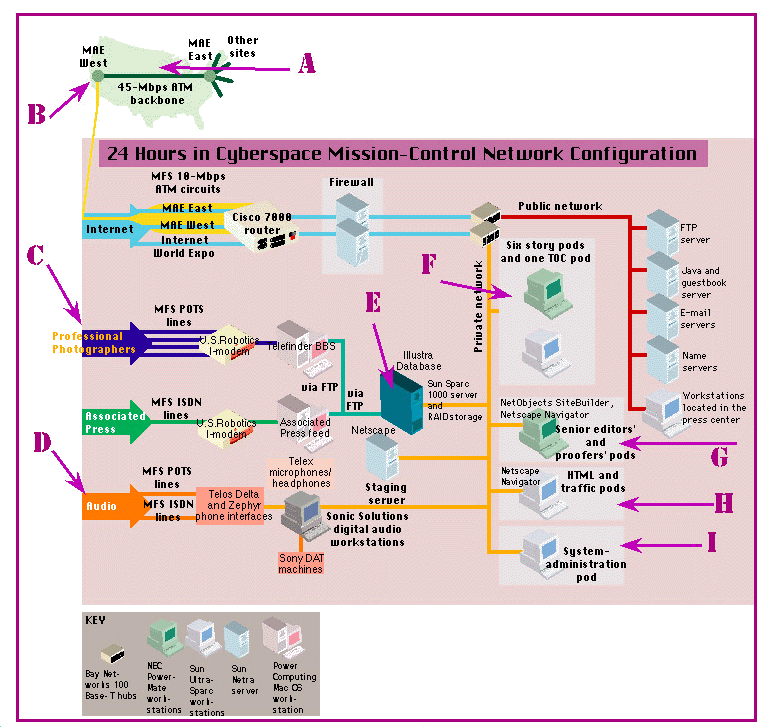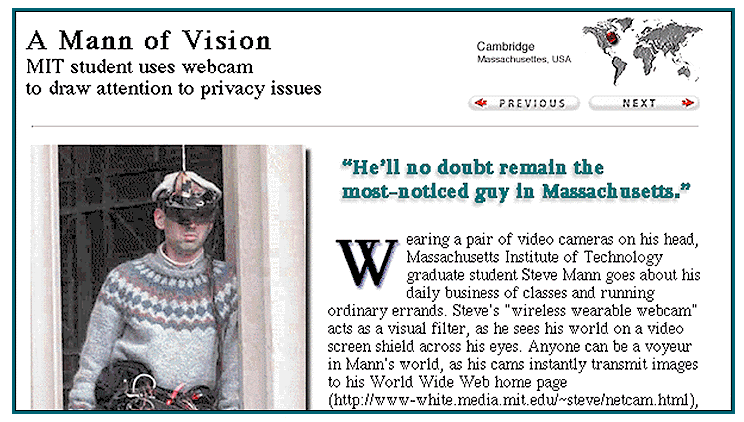| For 24 hours, it was the world's biggest Web site and
the most elaborate journalistic experiment in history. It
was also a revealing proving ground for new
technology — the same technology that forward-looking
content providers and businesses will have to master
before large-scale publishing and commerce on the Internet
become a reality. The 24 Hours in Cyberspace project began as another installment in a series of photodocumentaries masterminded by Rick Smolan, a former National Geographic photographer. This time, Smolan tried to document how people around the world are using computer technology, especially the Internet and the Web. He also decided to publish some of the stories on the Web the same day, to be followed later by his usual coffee-table book and CD-ROM. What began as an interesting journalistic project soon mushroomed into a massive technical challenge. Smolan had to build the biggest (in terms of installation size) Web site ever contemplated, staff it with skilled personnel, find software that could generate attractive Web pages in minutes, and keep the whole thing running for 24 hours with no downtime. To raise the stakes still further, the project itself became a media event. Not everything went according to plan. The project was almost torpedoed by technical problems, including a mysterious memory leak that caused the database server to lose 175 MB of RAM per hour. However, Smolan's all-star team of technical wizards managed to keep the Web site alive, and it recorded more than 4 million hits that day. (Netscape's home page can record up to 10 times that number on a busy day, but the 4-million count is nevertheless impressive.) More important, Cyber24 previewed what any business will face if it tackles Web publishing on a similar scale. The project's sponsors (nearly 50 companies, led by Adobe, Kodak, and Sun Microsystems) lent hardware and software worth more than $5 million, plus some of their best experts. Smolan also hired a few technical gurus of his own. Last November, about three months before the February 8 event date, they started building their 6000-square-foot "mission control" in San Francisco. From the beginning, it was an invent-as-you-go project. For instance, most Web sites follow a traditional publishing model in which someone creates Hypertext Markup Language (HTML) pages off-line and posts them on a server for browsing by users. But the Cyber24 site had to do much more. It accepted raw input in the form of ASCII text, scanned photographs, and digitized audio; provided about 80 writers, photo editors, and sound technicians with the tools to rapidly shape that material into HTML pages; and staged the finished pages on a network of 14 mirrored Web servers in the U.S., bridged to five more mirrors throughout the world. (For a look at how the information flowed, visit the 24 Hours in Cyberspace site at http://www.cyber24.com, also scheduled to be their permanent home.) The torrent of incoming data came not only from the 150 professional photographers that Smolan deployed from the Arctic Circle to South Africa, but also from everyday users who uploaded submissions. More than 1000 photographers in 27 countries shot 6000 rolls of film and hundreds of digital images. Everything had to be archived for later use in the book and CD-ROM. Nobody knew how much capacity or bandwidth they'd need, so they prepared for the worst. MFS Communications hooked the Cyber24 site directly into its prime Internet hubs on the Atlantic and Pacific coasts. These hubs, known as Metro Area Exchange (MAE) East and MAE West, are the gateways to a high-speed fiber-optic backbone that uses asynchronous transfer mode (ATM) and synchronous optical network (SONET). DS-3 and T1 lines connected project servers to the hubs. At mission control, the high-speed lines from MAE West were funneled through a NetEdge ATM bridge and a Cisco 7000 router. Sun's Firewall-1 security software guarded against intruders. Behind this wall, technicians assembled four Fast Ethernet (100Base-T) LANs, plus a MediaNet Fiber Distributed Data Interface (FDDI) ring. Sun lent 60 of its latest UltraSparc workstations, two SS-1000 database servers (each with eight CPUs, 1 GB of RAM, and an 84-GB RAID-5 disk array), and three Netra servers for FTP and E-mail. NEC Electronics lent 25 PowerMate PCs with 100-MHz Pentiums. There were also some Mac clones from Power Computing, mostly in the audio-processing studio. The latter systems had FDDI cards from Sonic Solutions and Telos Zephyr ISDN boxes. Collectively, the Cyber24 site had 11,000 MB of RAM and 300 GB of mass storage. The project leaders made some surprising software choices. The story editors created all their Web pages with an automated layout tool from NetObjects (Redwood City, CA). NetObjects is a tiny start-up company, and its prototype layout tool is so new it doesn't even have a name. Yet the editors successfully created 63 multipage stories without writing any HTML code. For their database software, the project leaders bypassed the more obvious choices in favor of Illustra, a relatively new relational DBMS from Illustra Information Technologies (Oakland, CA). Illustra is particularly good at handling multimedia data types, and the Cyber24 project generated many gigabytes of digitized photos, audio clips, and text. Adobe Photoshop was the logical choice for picture editing. The Cyber24 team sprang another surprise by tying all this software together with a custom front end that was based on templates displayed by Netscape Navigator. In other words, they pushed the underlying OSes so far into the background that they were virtually transparent to the editors. "We have Mac bigots, Windows bigots, Sun bigots, and typewriter bigots," explained William J. Ray, Illustra's director of market development. "They don't have time to worry about what the right mouse button does on this computer or what the left button does on that computer. They can just sit and start working." Amazingly, when the big day arrived, everything worked. Well, almost. The technicians never did trace the source of that 175-MB-per-hour memory leak. The network slowed to a crawl when the server dwindled to about 300 MB of RAM. However, they recovered the memory by rebooting the server every four hours, a solution good enough for a short-term project. When it was over, they began tearing down what they had labored three months to build. It may be years before anyone constructs another Web site on this scale, but when they do, they'd be wise to hire some Cyber24 veterans as consultants. A century ago, the modern mass media was born when newspapers advanced from hand-set type and single-sheet platen presses to Linotype machines and high-speed rotary presses. In the near future, the on-line mass media will advance from hand-coded HTML pages and narrowband modems to automated layout software and broadband networks. Some of that new technology will trace its ancestry back to 24 Hours in Cyberspace. 24-Hours in Cyberspace Mission-Control Network Configuration B: Students and others shot photos and created Web pages that were sent to mission control via the Internet. MFS Communications and Internet MCI connected mission control to the Net. C: Professional photographers took photos in the field using Kodak digital and normal cameras and prepared them with Adobe Photoshop. Many photographers uploaded images over regular telephone lines from their NEC portable computers to mission control. D: Audio interviewers debriefed photographers by phone. An audio team using Power Computing Mac clones and Sonic Solutions' digital audio software on an FDDI network edited interviews and put finished clips in the Illustra database. E: Database from Illustra scans incoming photos and stories, reads E-mail, places content in Database, and serves as the central content manager for the editors. F: Six teams (each with a photo editor, a text editor, and a technician sharing two NEC PowerMate and Sun UltraSparc workstations) edit story images, text, and audio before filling in a NetObjects template. A table of contents (TOC) team views and assigns stories to themes. G: A team of senior editors reviews stories and updates the site's home page. H: The traffic team monitors incoming stories and photos and gives technical support to reporters and assistants in the field. I: System administrators monitor the network and keep it secure using UltraSparc workstations. A Mann of Vision Cyber24's permanent Web site was scheduled to go on-line in March at http://www.cyber24.com. Copyright 1994-1998 BYTE |